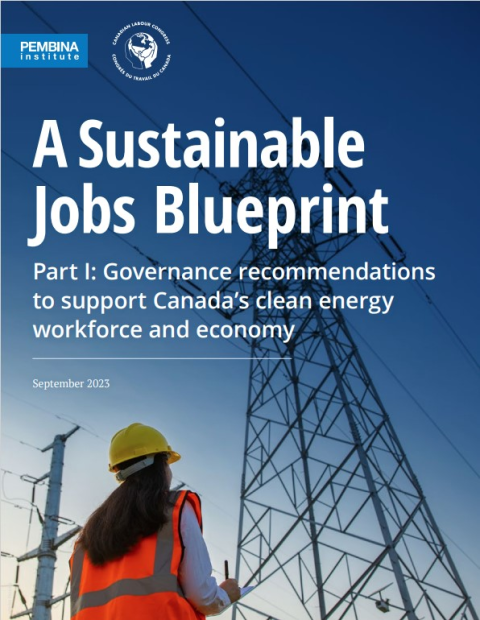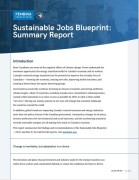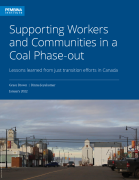The effects of climate change are becoming increasingly clear, and countries are beginning to react. To mitigate further climate change while maintaining economic stability, the demand for lower-carbon energy is growing — and workers in high-emitting sectors must be supported through this transition to a clean energy economy. Governments need to help the regions most impacted by the transition prepare for what is already underway and take proactive steps to avoid stranded assets and stranded workers. Other countries including Germany, Spain, Scotland, New Zealand, the United States and Denmark have already modelled components of successful governance to support the transition to sustainable jobs.
In 2023, Canada produced its first federal Interim Sustainable Jobs Plan. This was followed by the tabling of the Sustainable Jobs Act in June 2023 which outlines an approach to creating a prosperous net-zero future for all Canadians. This act represents the beginning of a framework to ensure that workers and communities are at the table, not on the menu. A variety of labour and environmental organizations have endorsed this act as a promising step to centre workers in the conversation; they maintain, however, that amendments must be made to ensure the implementation lives up to its potential. As echoed in the aftermath of less successful transitions, workers want to see a practical plan so that they can make informed decisions about their future. Workers need to see policies that speak to their concerns, and more than ever they must hear about effective solutions from trusted messengers. Workers need to be on-board for transition to be successful.
An energy transition will indisputably result in socioeconomic changes in Canada. In fact, it already has — workers with skills that are transferable to low-carbon industries are increasingly sought after to support these emerging pathways. Climate regulations and policy decisions represent only one driver of change. In a globalized, rapidly warming, and technologically advancing world, many trends affect jobs and the economy. In addition to climate change, this includes demographic change, human migration, and technological innovation. Proactive and responsive governments can put in place the foundations for stability through transitions that empower worker and community resiliency and ensure those socioeconomic changes are positive. These foundations include key enabling factors and mechanisms for collaboration, accountability, and implementation.
 This report is the first of a series of reports that will explore various policy themes associated with the sustainable jobs legislation. Read the second piece, A Sustainable Jobs Blueprint, Part II: Putting workers and communities at the centre of Canada’s net-zero energy economy. Collectively, these will form a Sustainable Jobs Blueprint for the Government of Canada, provinces and territories, and other stakeholders to inform policy decisions in the near and long term.
This report is the first of a series of reports that will explore various policy themes associated with the sustainable jobs legislation. Read the second piece, A Sustainable Jobs Blueprint, Part II: Putting workers and communities at the centre of Canada’s net-zero energy economy. Collectively, these will form a Sustainable Jobs Blueprint for the Government of Canada, provinces and territories, and other stakeholders to inform policy decisions in the near and long term.
Enabling factors
Enabling factors are elements that create the right environment for the success of sustainable jobs initiatives as a whole:
- Adequate resourcing: The financial resources needed to accompany this shift are significant and must be at a scale to strengthen a workforce that fuels Canada’s new energy economy.
- Alignment with net-zero: Plans to transition Canada’s workforce to sustainable jobs must ensure that jobs are, in fact, aligned with a net-zero economy.
- Cohesive strategy and vision: A sustainable jobs plan must be a part of the Government of Canada’s broader climate agenda.
- Regional collaboration: Transitions unfold at the regional and local level; a nation-wide sustainable jobs plan should reflect this diversity.
- Social dialogue: Whenever possible, workers, communities, and underrepresented groups should be a part of sustainable jobs governance structures and implementation.
- Worker buy-in: The elements listed above must ultimately be communicated to workers, through trusted channels, so workers can have the confidence that these initiatives will ultimately meet their needs.
Governance frameworks to steer a new energy economy
Establishing a robust governance framework is the basis for bringing government, industry, workers, and communities together, to steer policy and planning decisions and create a thriving energy workforce in the near and long term. From a jurisdictional scan and interviews with experts, we recommend five criteria be incorporated into jobs planning for a net-zero economy:
- Accountability mechanisms: Accountability mechanisms hold decision-makers responsible to their commitments by clearly articulating intentions, setting pathways to measure progress, and adapting them over time.
- Federal coordination mechanisms: Federal coordination involves delegating responsibilities and establishing ways of aligning efforts.
- Regional coordination mechanisms: Coordination between provinces and national-level governments is necessary to best support regions and communities undergoing energy and economic diversification.
- Advisory and engagement mechanisms: Governments should establish advisory bodies to hear directly from interest groups and experts during policy development.
- Dedicated implementation body: Establishing an implementation body can ensure that there is a central group with a mandate to oversee policy advancement.
Recommendations to set the foundation
This is a landmark year as the Government of Canada begins to implement its interim Sustainable Jobs Action Plan and aims to finalize the Sustainable Jobs Act. To set the foundation, the Pembina Institute and Canadian Labour Congress (CLC) provide the following recommendations:
Make legislative amendments to the proposed Act which will strengthen guiding principles and requirements for future action plans. Specifically, we recommend that the Government of Canada:
- add additional guiding principles to the preamble of the Act;
- consider the unique circumstances of rural, remote, resource-dependent and transitioning communities;
- strengthen and add key definitions;
- strengthen reporting requirements around key policy areas; and,
- ensure coordination between Sustainable Jobs Action Plans and Emissions Reduction Plans.
Set the Partnership Council up for success by giving them the tools to meaningfully shape the trajectory of sustainable jobs plans. Specifically, we recommend that the Government of Canada:
- establish terms of reference aligned with the Act’s principles;
- strike working groups to investigate specific lines of inquiry related to sustainable jobs;
- provide adequate resources to ensure that the full breadth of opportunities and risks of transition can be considered; and,
- formalize the relationship between the Partnership Council and the Net-Zero Advisory Body.
Establish an effective Secretariat which will improve policy integration, and coordination, as well as provide a source of information and support for workers. Specifically, we recommend that the Government of Canda:
- defines focus areas for the Secretariat in line with the Act’s principles; and,
- take a strategic approach to Secretariat structure by establishing understandings with key departments.
These recommendations are based on a jurisdictional scan of what other countries have done in their energy economic and workforce planning, learnings from other workforce transitions in Canada, and worker and stakeholder input. They are meant to help the Government of Canada strengthen their Sustainable Jobs policy and planning so that its implementation will support workers and communities.






